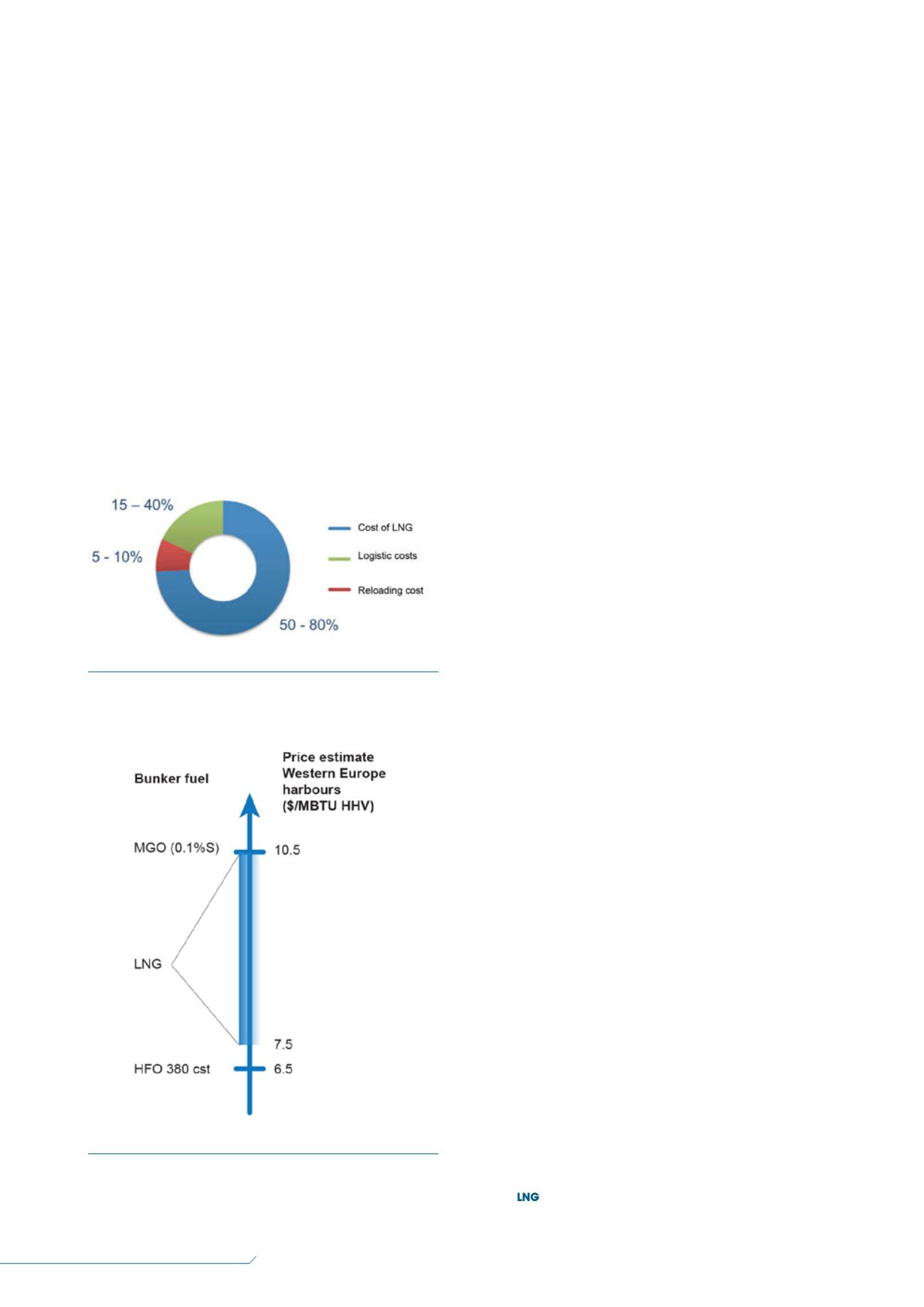
68
LNG
INDUSTRY
APRIL
2016
to the secondary markets. The current fleet is limited to
57 vessels worldwide (31 in fleet, 26 on order), including
34 vessels in Europe. Currently, the availability of these
vessels on the spot market is restricted. Some of them are
specially equipped with bunkering features (flexible hoses
andmasts or articulated LNG transfer arms). In 2015, an LNG
bunkering vessel with a capacity of approximately 5000m
3
cost in the region of €50million (approximately five times
more than a traditional fuel oil bunker vessel). Regular
rotations fromDunkirk of a 4000m
3
bunker vessel can
achieve an LNG flow of up to 80 000m
3
/month. The bunker
vessel scheme is shown in Figure 5
Shore tanks: acting as a large reserve of LNG, shore tanks
could be suitable for the Seine river valley as they would
help to regulate the flow of LNG. In 2015, the construction
of a 20 000m
3
shore tank with associated jetty represented
a budget of approximately €55million. In France, the safety
authorities must give their approval for any shore tank of over
110m
3
through a procedure that includes a SEVESO risk study.
The shore tank scheme is shown in Figure 6.
LNG markets
In 2015, LNGwas mainly shipped in large volumes (typically over
160 000m
3
) between liquefaction facilities and import terminals
by LNG carriers.
Transporting smaller amounts of LNG to secondary sites
requires different methods. Bunker trucks are a cheap and practical
solution to start with in an emerging LNG bunkeringmarket, but
the amount of fuel they can transport is limited.
For transporting larger volumes of LNG as fuel, small LNG
carriers should be used.
In 2015, the small scale LNGmarket was not mature and was
characterised by a small fleet worldwide, especially in Europe,
with few spot chartering possibilities.
Chartering a small scale LNG carrier on a long-termbasis
remains possible, but is not without risk as long as the demand for
LNG remains unsure.
LNG pricing
To answer the ‘chicken and egg’ dilemma, LNGmust become a
competitive fuel compared toMGO and HFO. This is likely to be
the only condition that will enable the widespread use of LNG as
marine fuel.
To date, the price of LNG is made up of the following
(Figure 7):
The LNG import price.
The reloading fee at the terminal.
The distribution and bunkering costs. Depending on the
efficiency of the LNG supply chain, reloading and logistic costs
may account for 20 – 50%of the LNG bunkered price to the
vessel.
Margins (traders, operators, etc.).
By autumn 2015, the price of LNG delivered to ships was
situated in a range between theMGOprice and the HFOprice
(Figure 8), for a given quantity of energy.
In the comingmonths or years, price is likely to be themost
important factor that ship owners will take into account before
making the decision to shift to LNG.
Conclusion
A global shift away fromHFOor MGOwill continue to generate
demand for LNG. However, small quantities of LNG can not be
handled by merely downsizing the practices of large scale LNG
carriers for the following reasons:
Small scale LNG vessels are not smaller versions of Q-Max
carriers or equivalents, and, therefore, have different
functionalities.
The shipyards that are able to build cost-effective small scale
LNG vessels will not be the same as the ones that built large
scale vessels.
A new logistic scheme with players shall be established to
distribute LNG to any end-user in ports.
For the French harbours, being ready for this major change is
a challenge if they wish to offer LNG bunkering services to their
customers.
After this study, an effective legal and operational framework
is now in place in those harbours for LNG bunkering to take
place.
Figure 7.
Typical price breakdown of LNG as fuel, based on
November 2015 European spot prices (source: Bergen Energi).
Figure 8.
Typical price level indication based on
November 2015 European forward prices (source:
Marine Assistance/Bergen Energi).


